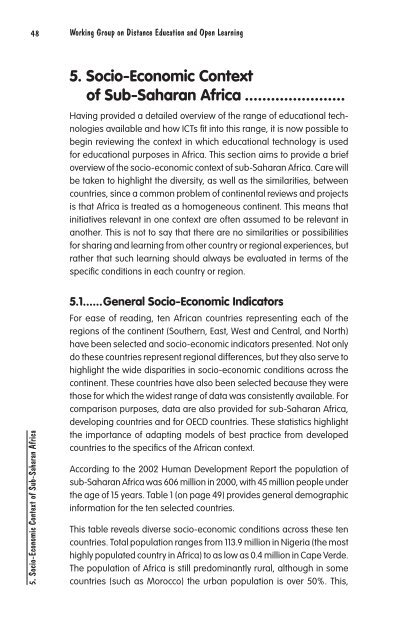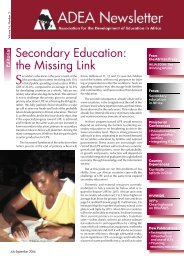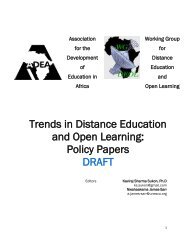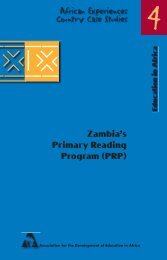Technological Infrastructure and Use of ICT in Education in ... - ADEA
Technological Infrastructure and Use of ICT in Education in ... - ADEA
Technological Infrastructure and Use of ICT in Education in ... - ADEA
Create successful ePaper yourself
Turn your PDF publications into a flip-book with our unique Google optimized e-Paper software.
48 Work<strong>in</strong>g Group on Distance <strong>Education</strong> <strong>and</strong> Open Learn<strong>in</strong>g<br />
5. Socio-Economic Context<br />
<strong>of</strong> Sub-Saharan Africa .......................<br />
Hav<strong>in</strong>g provided a detailed overview <strong>of</strong> the range <strong>of</strong> educational technologies<br />
available <strong>and</strong> how <strong>ICT</strong>s fit <strong>in</strong>to this range, it is now possible to<br />
beg<strong>in</strong> review<strong>in</strong>g the context <strong>in</strong> which educational technology is used<br />
for educational purposes <strong>in</strong> Africa. This section aims to provide a brief<br />
overview <strong>of</strong> the socio-economic context <strong>of</strong> sub-Saharan Africa. Care will<br />
be taken to highlight the diversity, as well as the similarities, between<br />
countries, s<strong>in</strong>ce a common problem <strong>of</strong> cont<strong>in</strong>ental reviews <strong>and</strong> projects<br />
is that Africa is treated as a homogeneous cont<strong>in</strong>ent. This means that<br />
<strong>in</strong>itiatives relevant <strong>in</strong> one context are <strong>of</strong>ten assumed to be relevant <strong>in</strong><br />
another. This is not to say that there are no similarities or possibilities<br />
for shar<strong>in</strong>g <strong>and</strong> learn<strong>in</strong>g from other country or regional experiences, but<br />
rather that such learn<strong>in</strong>g should always be evaluated <strong>in</strong> terms <strong>of</strong> the<br />
specific conditions <strong>in</strong> each country or region.<br />
5. Socio-Economic Context <strong>of</strong> Sub-Saharan Africa<br />
5.1......General Socio-Economic Indicators<br />
For ease <strong>of</strong> read<strong>in</strong>g, ten African countries represent<strong>in</strong>g each <strong>of</strong> the<br />
regions <strong>of</strong> the cont<strong>in</strong>ent (Southern, East, West <strong>and</strong> Central, <strong>and</strong> North)<br />
have been selected <strong>and</strong> socio-economic <strong>in</strong>dicators presented. Not only<br />
do these countries represent regional differences, but they also serve to<br />
highlight the wide disparities <strong>in</strong> socio-economic conditions across the<br />
cont<strong>in</strong>ent. These countries have also been selected because they were<br />
those for which the widest range <strong>of</strong> data was consistently available. For<br />
comparison purposes, data are also provided for sub-Saharan Africa,<br />
develop<strong>in</strong>g countries <strong>and</strong> for OECD countries. These statistics highlight<br />
the importance <strong>of</strong> adapt<strong>in</strong>g models <strong>of</strong> best practice from developed<br />
countries to the specifics <strong>of</strong> the African context.<br />
Accord<strong>in</strong>g to the 2002 Human Development Report the population <strong>of</strong><br />
sub-Saharan Africa was 606 million <strong>in</strong> 2000, with 45 million people under<br />
the age <strong>of</strong> 15 years. Table 1 (on page 49) provides general demographic<br />
<strong>in</strong>formation for the ten selected countries.<br />
This table reveals diverse socio-economic conditions across these ten<br />
countries. Total population ranges from 113.9 million <strong>in</strong> Nigeria (the most<br />
highly populated country <strong>in</strong> Africa) to as low as 0.4 million <strong>in</strong> Cape Verde.<br />
The population <strong>of</strong> Africa is still predom<strong>in</strong>antly rural, although <strong>in</strong> some<br />
countries (such as Morocco) the urban population is over 50%. This,

















